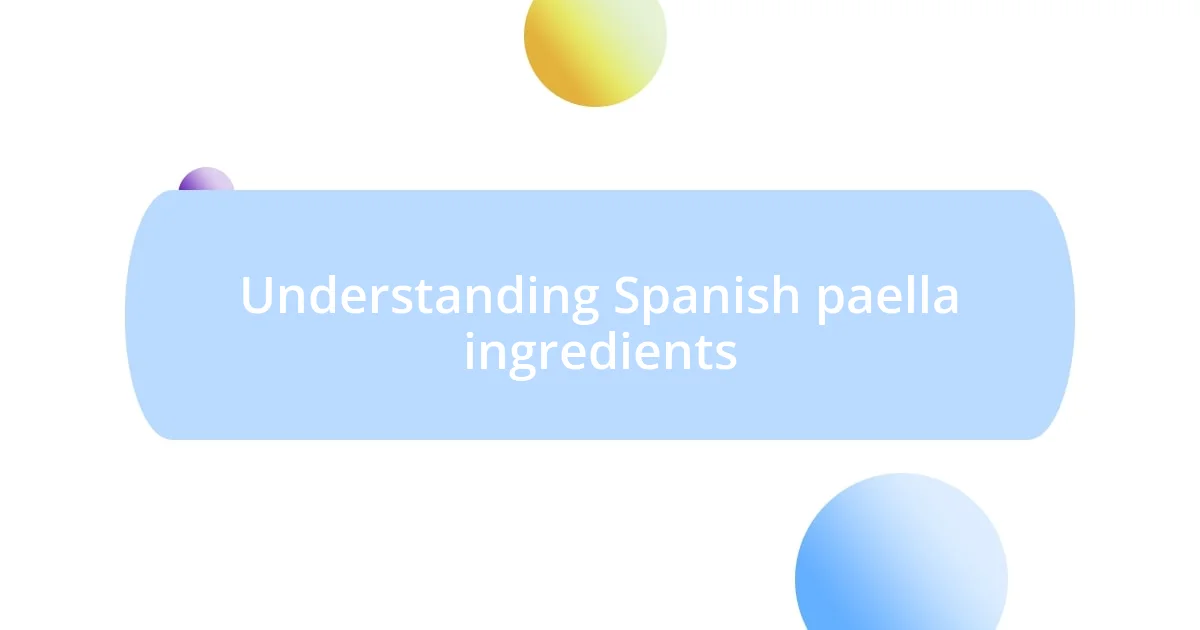Key takeaways:
- Using high-quality ingredients, such as saffron and seasonal vegetables, greatly enhances the flavors and authenticity of paella.
- Mastering essential cooking techniques, like searing proteins and allowing the paella to rest, is crucial for achieving a memorable dish.
- Avoiding common mistakes, such as using the wrong rice and adding too much liquid, is vital for creating the perfect paella with the desired texture and flavor.

Understanding Spanish paella ingredients
When I first embarked on my culinary journey to create authentic Spanish paella, the ingredients felt somewhat foreign to me. I vividly remember browsing through the vibrant farmers’ market, filled with the unmistakable scents of fresh herbs and spices. Did you know that saffron, the golden spice that gives paella its signature color, is actually the most expensive spice in the world? Its delicate floral notes elevate the dish, transforming it from simple rice to a feast that feels like a celebration.
The choice of meat and seafood can truly personalize your paella. The traditional recipes often call for rabbit, chicken, and sometimes a mix of seafood like shrimp and mussels. I recall a time when I decided to use locally caught calamari instead of the usual shrimp, and the sweet, tender morsels added a delightful twist that I will never forget. Have you ever considered how the freshness of your ingredients can change the dish completely? It’s almost magical to see how a handful of quality ingredients can take a simple meal and elevate it into something extraordinary.
Don’t overlook the importance of vegetables too! Fresh green beans, bell peppers, and tomatoes bring not only color but also layers of flavor to the dish. I remember striking up a conversation with a local chef who stressed the significance of using seasonal produce. He pointed out how each region in Spain puts its own spin on paella, adapting ingredients based on what’s fresh and available. It made me realize that cooking isn’t just about following a recipe; it’s about embracing the creativity and uniqueness that each ingredient brings to the table. What would you add to your own paella, knowing the potential flavors they could bring?

Mastering paella cooking techniques
Achieving the perfect paella requires mastering a few essential cooking techniques that transform simple ingredients into a memorable dish. One key aspect is the art of layering flavors through the careful sautéing of ingredients. I remember the excitement I felt the first time I properly caramelized my onions—such a small change, yet it brought a depth of sweetness to my paella that I hadn’t expected. The infamous “sofrito,” or flavor base, is an essential technique; it sets the tone for the entire dish.
Here’s what I’ve learned about essential paella cooking techniques:
- Searing: Begin by searing your proteins to create a rich flavor base.
- Timing: Add your rice at the right time. It should toast slightly before adding broth for a nutty flavor.
- Broth: Use homemade stock when possible—it’s a game changer for depth of flavor.
- Resting: Allow the paella to rest after cooking; this lets the flavors meld beautifully.
- Socarrat: Aim for that crispy bottom layer, known as socarrat, which adds a delightful texture and is considered a hallmark of a well-made paella.
Another critical practice I’ve adopted is the technique of adding broth gradually. I remember the first time I tried to rush this step, resulting in unevenly cooked rice. The way paella absorbs liquid is fascinating; it’s almost like each grain of rice becomes a little vessel, soaking up all those aromas and nuances. It’s in these small, mindful actions that I found not only improvement in my skills but also immense joy in the cooking process. Paella is much more than a meal; it’s a beautiful dance of flavors and techniques coming together to create something truly special.

Adding authentic flavors to paella
When it comes to adding authentic flavors to paella, spices play a pivotal role. I learned that the right combination can elevate the dish beyond just its visual appeal. The moment I tried adding smoked paprika—called “pimentón” in Spanish—it was like a flavor explosion in my mouth! The smoky undertones perfectly complemented the seafood and offered a depth that I didn’t experience before. Have you ever thought about how just one spice can change the entire character of a dish? It’s incredible!
Another essential aspect is the use of fresh herbs, particularly rosemary. I still remember the delightful aroma that enveloped my kitchen when I added the finely chopped leaves towards the end of cooking. The fresh, pine-like scent not only added a burst of flavor but also enhanced the overall experience of eating paella. Additionally, using lemon wedges to brighten up the dish before serving can make a remarkable difference. Have you tried squeezing fresh lemon over your paella? That zing can awaken the other flavors in such a beautiful way!
To sum it all up, don’t overlook the importance of layering flavors throughout the cooking process. Each addition—whether it’s aromatic spices, fresh herbs, or a splash of citrus—builds a complex taste profile that can transport your taste buds straight to Spain. I remember when I had a gathering with friends, and the paella turned out exceptional because of these little choices. We ended up sharing stories about our experiences with cooking while delighting in the unique flavors, reminding me that cooking is just as much about enjoyment as it is about technique.
| Ingredient | Flavor Impact |
|---|---|
| Saffron | Delicate floral notes and vibrant color |
| Smoked paprika | Adds depth with a hint of smokiness |
| Fresh herbs (e.g., rosemary) | Brightens flavor and adds aromatic elements |
| Lemon wedges | Enhances overall flavor with a fresh, zesty finish |

Serving suggestions for paella
When it comes to serving paella, presentation plays a significant role in enhancing the dining experience. I love to serve it directly from the pan—it adds a sense of occasion and a touch of authenticity. Picture this: everyone gathered around, the vibrant colors of the saffron-infused rice catching the light, and the steam wafting up as I place the heavy pan on the table. How can you resist diving into a dish that looks and smells so enticing?
Pairing simple sides is another fantastic way to elevate your paella. I’ve found that a fresh, crunchy salad works beautifully, providing a perfect contrast to the rich flavors of the dish. The first time I added a light arugula salad topped with a citrus vinaigrette, it was a game changer—each bite of paella was beautifully complemented by the bright, zesty notes from the salad. Have you ever thought about how a crisp side can balance out the heartiness of a main dish? It truly enhances the meal.
Don’t forget about garnishing! I can’t recommend enough the impact of a sprinkle of fresh parsley and some lemon wedges. When I served my paella adorned with these colorful accents at a recent dinner party, I noticed my guests couldn’t resist taking photos before digging in. That added pop of green not only brightens the dish visually but also invites everyone to squeeze a little lemon over their serving—a small but delightful action that amplifies the flavors beautifully. It’s these little touches that turn a simple dish into a memorable feast.

Common mistakes to avoid
One common mistake I encountered when first cooking paella was using the wrong kind of rice. I mistakenly thought any rice would do, but authentic paella demands short-grain rice, like Bomba or Calasparra. These varieties absorb liquid without getting mushy, creating that perfect al dente texture that keeps the dish authentic and enjoyable. Have you ever noticed how the right ingredient can truly transform a meal?
Another pitfall is incorporating too much liquid. I remember my initial attempts resulted in a soupy mess because I was so eager to infuse flavors. The key is to start with less liquid—it’s easier to add more if needed than to fix a watery dish. Trust me, achieving that savory socarrat—the crispy layer at the bottom—is nearly impossible if there’s too much moisture. Does that crispy texture play a vital role in your cooking? It certainly does for me!
Lastly, I’ve learned not to skip the resting period after cooking. It might seem like a small step, but letting the paella sit covered for about five to ten minutes before serving makes a world of difference. This brief pause allows the flavors to meld and the rice to finish cooking in its steam. I recall the first time I was impatient, serving it too soon; the flavors were good, but they lacked that harmonious blend. So, why rush when the wait can elevate your dish to something truly special?












